Amongst these contemplating the acquisition of a brand new or used battery-electric or plug-in hybrid automobile, or simply interested by EVs, charging can nonetheless be the EV dealbreaker.
Except you don’t have a technique to simply set up or entry dwelling charging, your excuses are shortly disappearing, although. In 2024 public charging stored tempo—or higher—with the variety of EVs on the highways. New EVs are charging faster and extra persistently in highway journeys; the choices alongside the way in which have grow to be extra dependable; and with Tesla and different manufacturers’ EVs all quickly suitable with the identical cost connectors, no one’s excluded.
That stated, conserving EVs charged requires a unique mindset than you would possibly use in fueling up gasoline vehicles—despite the fact that seeing electrical energy as gasoline isn’t off the mark.
A well-recognized place to begin for EV charging
When you’re an EV beginner, or somebody simply feeling out EV possession, you possibly can look ahead to a lifetime freed from gasoline. However as a way to get pleasure from it and shed the nervousness, you’ll have to interrupt out of the running-on-empty and fill-’er-up mindsets of gasoline autos, changing it with the charge-nightly-or-as-you-can method you already use for smartphones or tablets.
Changing into comfy with the routine of charging your EV—and when and the place you could plug in—is a vital a part of possession. And all of it comes again to what’s probably in your pocket or proper subsequent to you, in the event you’re not already studying this piece on it—your smartphone.

Rivian provides Tesla Superchargers to journey planning app
Over time, some folks be taught to have faith within the battery stage of their cellphone, regulate it, and easily plug it in when it will get down to twenty% or 10%—the low battery warning—whereas others get in a routine to plug in each night to cost up all or a lot of the method for the subsequent morning, relying on settings.
Whereas EV batteries are larger, and you may’t plug them in in all places, conserving your EV charged up is all about what makes the very best sense to you. Not everybody goes to return to the identical conclusions, and that’s positive as EV possession can match all types of routines, so long as you first perceive charging.
With that place to begin in thoughts, be forewarned: When you’re already an EV fan, a lot of this will probably be previous hat. However to make the transition simple, Inexperienced Automotive Experiences has rounded up some recommendations on how, the place, and when find out how to cost up that new plug-in automobile.
We’ve written this piece with the tech-curious newbies in thoughts—perhaps not hitting all of the positive particulars, however serving to present a lay of the land as you shift away from gasoline and towards cost ports and ensure all fundamentals are in place.
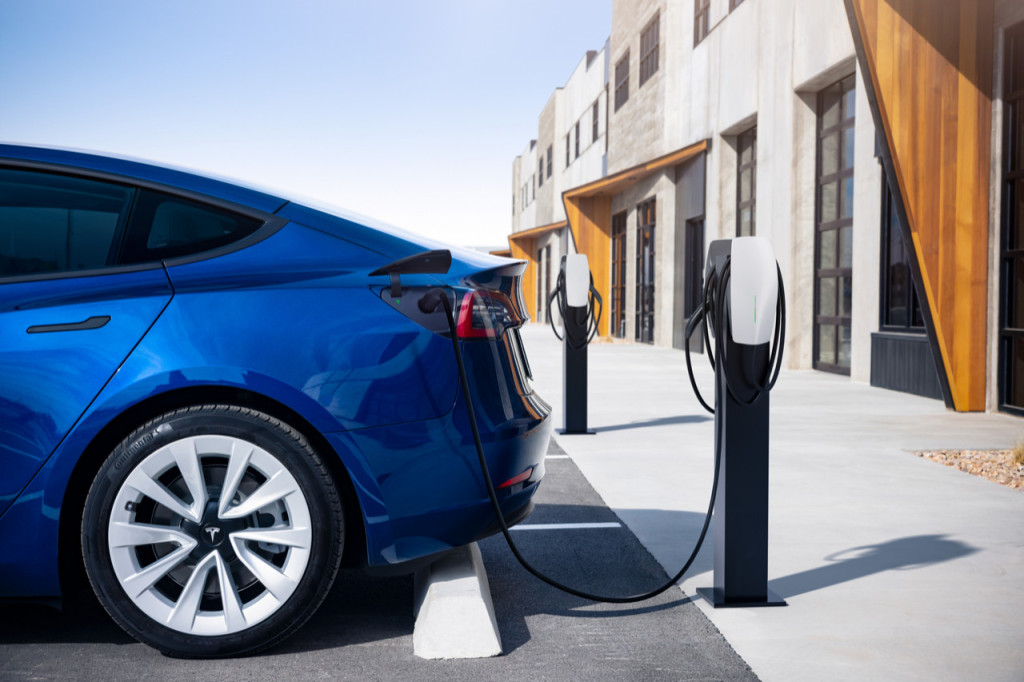
Tesla charging
Varieties of Charging
AC or DC
Essentially, there are two varieties of charging, primarily based on the format of the electrical energy—AC and DC.
AC (alternating present) is what’s equipped to your house or what flows by way of a industrial electrical outlet—or the “vacation spot chargers” that you just would possibly plug into for just a few hours, or in a single day. Whether or not you plug into it through a cell connector or a wallbox, the precise charger that communicates with the battery and converts that AC present to DC (direct present) and is inside the automobile.
The cell connector or wallbox (generally known as EVSE for the sake of tax credit, rebates, or electrical work) will check the circuit while you plug it in, to make sure that it is correctly grounded and the present is robust sufficient to energy the charger. Despite the fact that these connectors and wallboxes aren’t delivering the electrical energy in any totally different format than what the outlet offers, they’re confusingly usually known as chargers.
DC itself, however, is often equipped by industrial charging-station {hardware} designed for quick charging (or very particular makes use of like dwelling backup). {Hardware} delivers DC present to the automobile, with two-way communication fine-tuning precisely what voltage and present the battery pack will get in actual time to get the quickest cost with out overheating the pack or damaging it.

2023 Nissan Ariya at EVgo charging station
L1, L2, and L3
AC and DC charging breaks out into a spread of charges, which ends up in one other technique to describe the varieties of charging: Degree 1 (L1), Degree 2 (L2), and Degree 3 (L3).
Remember that these ranges are much less related in Europe, however they persist in North America, due to the way in which our AC electrical energy is delivered.
These roughly correspond to:
Degree 1: As much as 2.4 kw
Degree 2: 2.4 kw to 19.2 kw
Degree 3: 24 kw and up
Quick charging at present is shifting to consult with connectors able to delivering 150 kw or extra. Many charging station connectors stay restricted to 50 kw, and a few older {hardware} could solely be able to delivering 24 kw, however they nonetheless fall underneath what’s known as L3.
An L1 charging price probably received’t be sufficient to maintain a completely electrical automobile adequately charged up at dwelling, until commutes are quick and it’s plugged within the overwhelming majority of the time in any other case. Nevertheless it is likely to be positive for a plug-in hybrid. These are inclined to correspond with 120V AC supply and thus are often restricted to 1.44 kw (120 volts x 12 amps — and we’ll get to why it’s 12A a bit later). Figuring in an affordable 10% losses, you’re solely placing about 1.3 kwh into the battery pack per hour—or about 5 miles of vary per hour in additional environment friendly EVs just like the Tesla Mannequin 3/Y or Chevy Bolt EV.
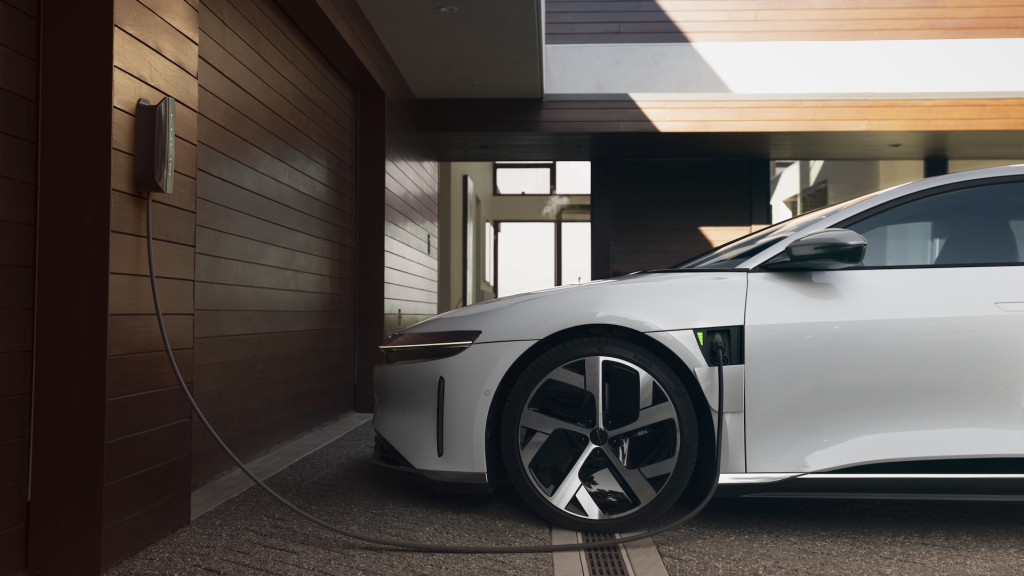
Lucid Linked Residence Charging Station
L2 is the simplest and greatest choice to have for EVs, as it may present a full in a single day cost for almost all EVs—all however these with the most important battery packs. These are sometimes wallboxes and basically correspond with 240V AC supply, and if in case you have a charging station put in at dwelling, it should require the identical sort of wiring as an electrical range or garments dryer. Tesla, as an illustration, factors to as much as 44 miles of vary recovered per hour from its Wall Connector.
EVs and plug-in hybrids have sometimes include a “charging wire” permitting you to plug into 120V AC and get that sluggish L1 charging when wanted. However these actually weren’t used very steadily. So automakers have been switching towards 120V/240V cell connectors, that are as an alternative usually non-compulsory on new EVs (and customary on just a few premium-brand fashions) however do at an L2 price add a really helpful quantity of vary if in case you have entry to a spare 240V outlet. Tesla’s cell connector, as an illustration, is restricted to 32 amps, which corresponds to as much as 30 miles of vary recovered per hour for the Mannequin 3, in keeping with the automaker.
Within the curiosity of simplification L3 and DC quick charging are one and the identical. So maintain studying for that.

Subaru Solterra EV at Electrify America
DC fast-charging fundamentals
Quick chargers ship direct present to your battery pack, whereas speaking along with your automobile. By various the voltage and present, and accommodating for particulars like battery temperature and ambient temp, quick chargers ship as a lot energy as your battery can deal with at a given state of cost—as much as the rated most of the connector, wire, and charging cupboard.
That successfully implies that in the event you select a charging location and connector rated at or above your automobile’s most, usually, the {hardware} will have the ability to cost your automobile up in as little time as doable.
However the cells should be in an excellent temperature zone to hit that peak price. So main as much as a fast-charge session (and in lots of circumstances linked to its route planner), your automobile could precondition its battery pack—which suggests heat it as much as the low finish of the perfect zone. They’ll warmth up extra when charging.
In a DC fast-charging session, the cost price tends to sluggish as you method about 80%. Because of this, automakers sometimes give fast-charging occasions from 10-80%—an excellent window to hunt on lengthy highway journeys. Sadly that’s solely 70% of the vary, so as an illustration to spend the least time charging you’ll must cease about each 175 miles in a automobile that may go 250 miles on a full cost at real-world freeway speeds (which could correspond to an EPA vary score of 300 miles or extra).
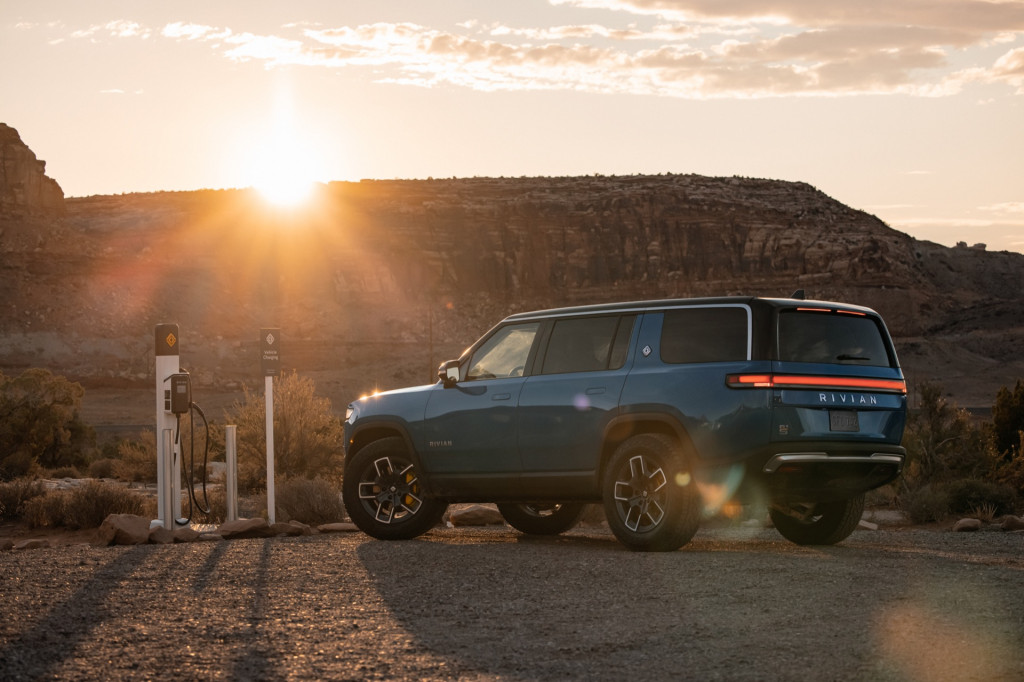
Underneath Canvas carbon-conscious camp with Rivian Waypoint chargers – Moab
The place to cost: Residence, vacation spot, and quick chargers
Distilling AC and DC, L1, L2, and L3 right down to some key factors, what it quantities to for real-world use is that there are three key varieties of chargers at which to cost:
- Residence chargers, or people who you retain at dwelling or in your trunk (or frunk)
- Vacation spot chargers—usually that means Degree 2 chargers which may be on the office, a shopping mall, or a parking storage and supply a major cost in just a few hours
- Quick chargers which can be most definitely alongside freeway road-trip routes, to offer a major cost in lower than an hour

2024 Volkswagen ID.4
The best way to discover chargers
We strongly suggest that you’ve got, on the prepared, a mixture of strategies to seek out your greatest charging-station choices. So in your smartphone, set up not simply the official model app on your automobile but in addition an unbiased app centered on charging and route planning.
Most of at present’s EVs do include some stage of charger-savvy route planning that includes dynamic vary estimates. Not all automaker apps and interfaces present the instruments for the quickest EV highway journeys, although. Unbiased EV charging apps we suggest for backing up your in-car interface and ensuring you’re selecting the very best stops alongside the way in which embody Chargeway, PlugShare, and A Higher Route Planner. Google Maps and Apple Maps do additionally now embody some charger specs.
You’ll then must provoke the charging session—and pay for it, in lots of circumstances. Though within the case of Tesla, you’ll probably solely must plug in. For these with different EVs, Plug & Cost expertise permits an analogous stage of comfort though it’s not but working in all places. In different circumstances it’s possible you’ll want to offer a credit-card swipe or smartphone-based fee, however total the times of separate playing cards, apps, fobs, and passkeys for every charging community are fortunately on the way in which to the historical past books—thanks partially to the federal authorities’s NEVI guidelines.

Fisker Wallbox dwelling charger
Putting in a house charger
For all of those dwelling chargers, whether or not they’re plugged into the suitable socket or hardwired, the 80% rule applies—that means that you just shouldn’t be pulling a continuing load that exceeds greater than 80% of the max your circuit is wired for. So as an illustration, for a 50-amp circuit, try to be utilizing a charger that received’t pull greater than 40 amps.
A few of at present’s long-range EVs are able to charging at as much as 19.2 kw, which signifies an 80-amp cost connector, requiring (given the 80% rule) a 100-amp circuit. With 200-amp service for the whole home fairly frequent at present, and a few smaller or older properties operating on 125 amps or much less, that’s an untenable quantity to dedicate to EV charging with out main (and dear) electrical upgrades.
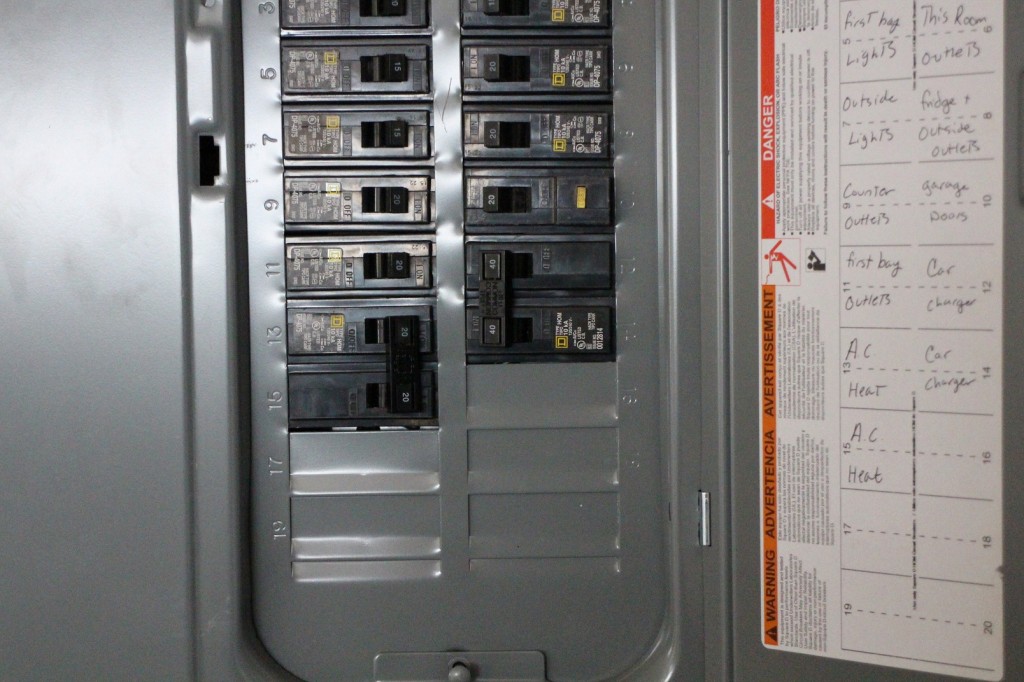
Circuit-breaker field displaying 240-Volt circuit for electric-car charging station
To be completely pragmatic, a 40-amp circuit and 32-amp dwelling cost connector will probably be simply positive, and lots enough for many EVs—amounting to a cost energy of as much as 7.7 kw. Even for a lot of longer-range EVs, that’s sufficient for a full cost in 10-14 hours in the event you’re close to zero cost remaining.
However step up the circuit in the event you can. A 60-amp circuit and 48-amp charger, as an illustration, will get you added velocity for among the greatest electrical vehicles or longer-range EVs, and transferring all the way in which as much as 100 amps for the circuit and 80 amps for the charger could have benefits for some fashions.
One closing word: It probably makes much more sense to put in a 100-amp circuit versus including two separate 50-amp circuits, as there are twin chargers that may break up out there amps between EVs. However there are load-balancing and power-sharing choices, too. Discuss to your electrician.
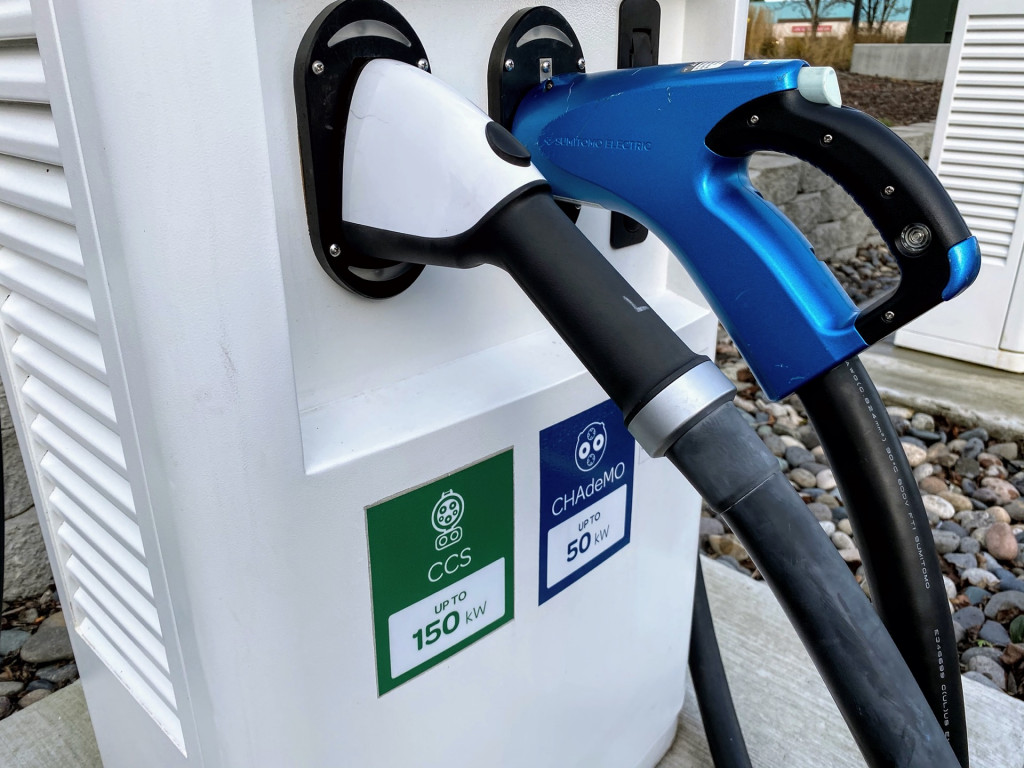
Electrify America DC fast-chargers – CCS and CHAdeMO
Cost connectors—J1772, NACS, CCS, CHAdeMO
A few of at present’s EVs include one cost port, whereas others include two. The rationale behind that is associated to AC and DC charging, however it’s somewhat extra sophisticated than that.
Most AC charging comes through the spherical J1772 cost port—the “J” plug that’s grow to be near-universal over the previous 15 years in EVs and plug-in hybrids. The identical port spans L1 and L2 charging, as much as about 19.2 kw.

U.S. market EV charging connectors – through ChargePoint
CCS. The Mixed Charging System, within the kind People understand it, is that very same J1772 port, with two stout DC-charging prongs added simply beneath, to allow Degree 3 DC quick charging (or maybe, in bidirectional charging setups, different slower sorts of DC energy sharing). Within the U.S., CCS arrived in late 2013.
NACS. The North American Charging System, or J3400 because it was termed as an industry-wide customary in 2023, is an adoption and evolution of the Tesla cost port that’s been used because the introduction of the Mannequin S in 2012. NACS is noteworthy for the way it combines AC and DC charging collectively in the identical compact cost port that some could merely discover simpler to make use of.
CHAdeMO. Conceived in 2009 and 2010 by a bunch of Japanese firms, CHAdeMO was first rolled out for the U.S. within the 2011 Nissan Leaf. The one two new autos utilizing the CHAdeMO port in 2024 are the Nissan Leaf EV and Mitsubishi Outlander Plug-In Hybrid. Whereas the port and customary had been forward of the curve with bidirectional charging totally enabled beginning in 2013, CHAdeMO was shunned in Europe. What’s additionally been rendering CHAdeMO moot is that the large, spherical port doesn’t embody AC/L2 charging—so in EVs the J1772 port must be included individually.
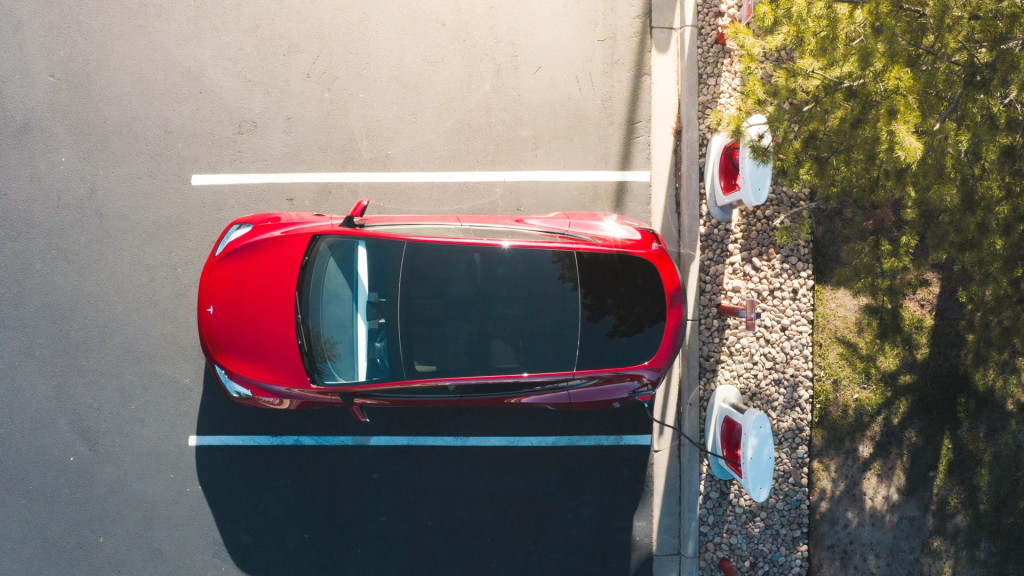
Tesla Supercharger
NACS or CCS: Two takeaways
The way forward for American EV charging is NACS. All through 2023, beginning with Ford, each single quantity U.S. automaker dedicated to the Tesla-based NACS format for future EVs—and, within the meantime, entry to the Tesla Supercharger community with CCS-NACS plug adapters. However many of those EVs that swap to that format aren’t due till later in 2025 or 2026,
Get used to adapters. Whereas the longer term is NACS, it’s possible you’ll be completely positive with CCS for dwelling charging for a few years to return. When you depend on public charging, even on highway journeys, you’ll most likely need to have an permitted adapter available.
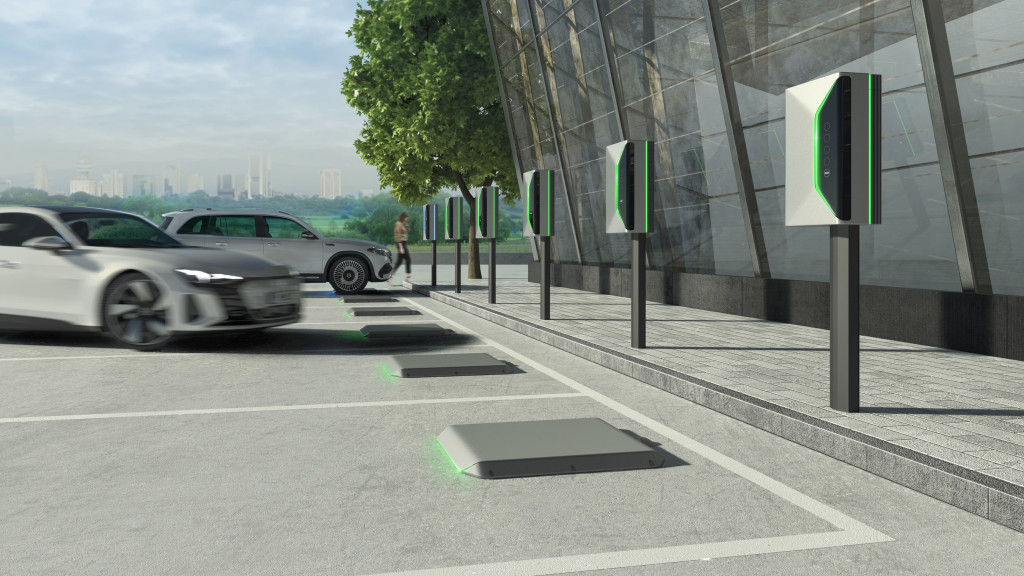
WiTricity and Siemens wi-fi charging station
A number of the way forward for charging will probably be wi-fi
Cables and connectors would possibly at all times stay a method of charging your EV, however they received’t be the one method. The expertise for totally wi-fi automobile charging—often known as inductive charging—has already arrived, and in the event you quick ahead just a few years into the longer term it’s fairly probably some U.S. EV drivers received’t ever want to fret about remembering to bodily plug in every evening.
The expertise depends on a set of copper coils at both finish—one in a pad on the storage ground, driveway, or parking area, the opposite on the backside of the EV. The decrease pad creates an oscillating magnetic discipline, which is then captured by the automobile’s coil and transformed again to electrical energy.
Why isn’t it in all places? For one, it’s costly, with the worth tag of a whole wi-fi charging set up costing a number of occasions what a wallbox prices. When luxurious EVs—and Tesla—undertake wi-fi charging, they’ll pave the way in which to economies of scale, and ultimately public wi-fi charging stations that may make your highway journey even simpler.
Quick ahead even farther into the longer term and dynamic inductive charging might imply that some EVs, on sure routes, would possibly by no means must cease to cost—because the tech would possibly regularly cost your automobile as you drive, by way of smaller embedded coils within the highway.
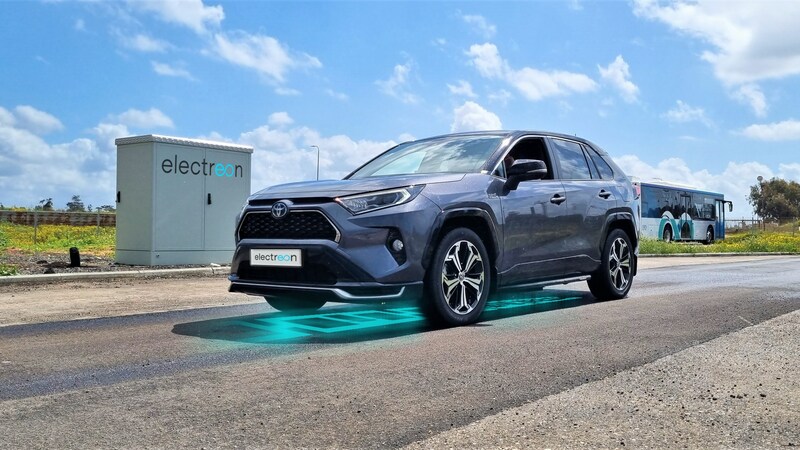
Toyota RAV4 Prime – Electreon dynamic wi-fi charging
Bidirectional charging is the wildcard
Typically, at present, EV charging includes power move in a single course—from the grid to your automobile. However sooner or later there is likely to be far more give-and-take to charging as EVs, dwelling {hardware}, and your public utility, maybe, embrace bidirectional charging. With it, known as out as V2H (automobile to dwelling), V2G (automobile to grid), V2X (automobile to every thing), EVs would possibly ship energy out to campsites or building websites, energy properties throughout brownouts or blackouts, or assist stability power at totally different prices or totally different ranges of demand.
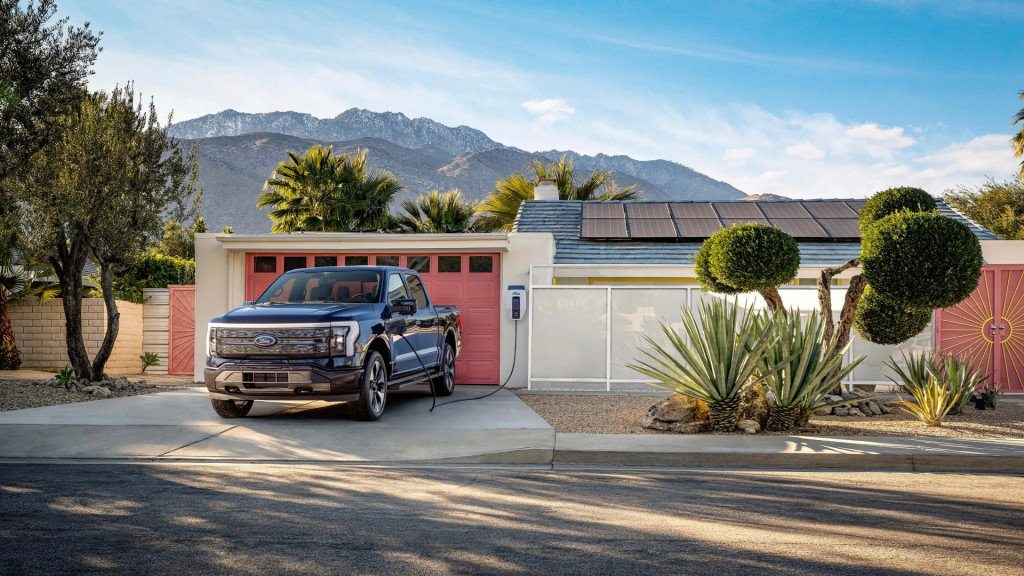
2022 Ford F-150 Lightning Clever Backup Energy
Farther off, a spread of firms, with totally different phrases, technical variations, and proposed guidelines, have floated the concept of an “open market” for bidirectional charging—in small quantities, over wi-fi charging. As an example, perhaps the grocery retailer borrows only a kilowatt-hour or two from a lot of the autos within the lot—wirelessly, primarily based in your settings—and in return offers you a reduction for decreasing its use of costlier grid electrical energy on a sizzling afternoon.
Some types of bidirectional charging are right here proper now. CHAdeMO has been totally suitable with bidirectional charging for greater than a decade, with the best {hardware} and software program, in fact. CCS has additionally provided this functionality for a number of years. Common Motors has expanded bidirectional charging functionality to the whole GM EV lineup and it’s readied a GM Vitality ecosystem together with power storage. And at current, the Ford F-150 Lightning, Nissan Leaf, and Kia EV9 and EV6 are among the many EVs which can be suitable with no less than some bidirectional {hardware}. In 2023 Tesla stated that inside about two years—that’s this yr—all Teslas will get bidirectional charging performance.

charging etiquette word – DC quick charger, Olympia WA
P.S. Don’t overlook your manners: EV charger etiquette
The objective is for all of us simply to get alongside.
Inexperienced Automotive Experiences has dug into this problem much more previously, when driving an EV felt like an unique membership of tech early adopters within the know. In 2025, it’s a really totally different scene than it was in say 2015—and the times of leaving passive-aggressive Put up-It notes on autos or distributing zines to fellow EV drivers (I’ve seen each) are principally left to tales of the way it was. However some guidelines of politeness maintain as a lot now as then.
Don’t overstay your welcome. Before everything, just remember to do not occupy the area longer than it takes your automobile to recharge. You wouldn’t abandon your automobile at a fuel pump when it’s not fueling, would you? Most charging networks cost idle charges in the event you stay plugged in, and charging spots aren’t there to offer parking.
Match EV and connector. When you can keep away from it, don’t use a connector/charger rated at a lot larger energy than your EV can benefit from. So Chevy Bolt EV house owners, please don’t use the 350-kw connectors, in the event you can keep away from it, whereas the Lucid Air or Chevy Silverado EV drivers who could make full use of it wait.
Respect! Don’t unplug anybody’s automobile till the cost is full, even when it’s simply to insert the 5 minutes of charging you could get dwelling. Most EVs have interlocks that allow you to select whether or not or not releasing the cost port requires the important thing current, so be sure you know your automobile.